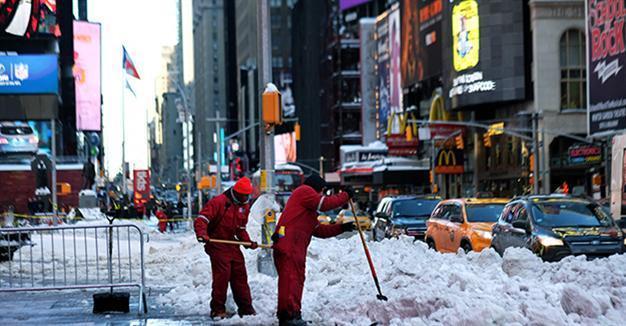US East Coast returns to normal after blizzard
NEW YORK / WASHINGTON - Reuters

Workers clean snow at Times Square in New York on January 25, 2016. AFP Photo
Major U.S. East Coast cities struggled yesterday to return to normal following a massive weekend blizzard that dropped about 60.96 centimeters of snow on cities including New York and Washington, while around 30 deaths were blamed on the snow storm.
Commuters faced delayed trains and buses and traffic was heavy heading into major metropolitan areas as many roads remained clogged with drifts of snow.
In Washington, the U.S. Office of Personnel Management said federal government offices were shut yesterday, while further north, the New York Stock Exchange and the city’s public schools were scheduled to open as usual.
At least 30 people have died from storm-related causes including traffic accidents and heart attacks while shoveling, with deaths reported in states stretching from Arkansas to New York.
Air travel remained seriously affected as some 1,390 U.S. flights were canceled on Jan. 25, with Newark Liberty International Airport, New York’s LaGuardia Airport and Washington Dulles International Airport the hardest hit, according to FlightAware.com.
More than 12,000 U.S. flights were slashed from Jan. 22 through Jan. 25, with some airlines cancelling flights into Jan. 26, FlightAware reported.
The blizzard was the second biggest snowstorm in New York City history, with 68 cm measured in Central Park by midnight on Jan. 23, shy of the record 68.3 cm set in 2006, the National Weather Service said.
The NWS said 57 cm fell in Washington at the National Zoo, and Baltimore-Washington International Airport notched a record 74.2 cm. The deepest regional total was 106.7 cm at Glengarry, West Virginia.
In the Washington suburb of Arlington, Virginia, on Jan. 25 the main thoroughfare leading into Washington was clear but virtually empty as secondary roads were clogged by slush and partly blocked by huge mounds of snow created by plowing.
Dozens waited for more than half an hour for the subway into downtown as limited metro service began.
“It’s beautiful to watch but impossible to get through,” said John Salmons, a 24-year-old designer who works at an architecture firm. “The main roads were fine it was just the secondary roads that were worst.”
Even with federal government offices officially closed, the Supreme Court was open for business, scheduled to issue rulings and act on pending appeals from the snowbound courthouse across from the U.S. Capitol building. In past storms, including hurricanes and blizzards, the court also remained open, even hearing oral arguments.
Cold snap hits east Asia
Meanwhile, unusually cold weather in eastern Asia has been blamed for more than 65 deaths, disrupted transportation and brought the first snow to a subtropical city in southern China in almost 50 years, the Associated Press reported.
Taiwan officials have blamed an unusually cold weather front for the deaths of at least 57 mostly elderly people in the greater Taipei area.
The cold snap was blamed in the deaths of 40 people in the capital, Taipei, while the neighboring New Taipei City attributed an additional 17 deaths to the cold weather. Strokes and hypothermia were among the causes of death in New Taipei City, officials there said.
The cold wave abruptly pushed temperatures to a 16-year low of 4 degrees Celsius in the subtropical capital where most homes lack central heating, causing heart trouble and shortness of breath for many of the victims, a city official said.
“In our experience, it’s not the actual temperature but the sudden drop that’s too sudden for people’s circulatory systems,” said a city spokesman who identified himself only by his surname, Chang.
A cold snap gripped Hong Kong on Jan. 24, with residents shivering as temperatures plunged to the lowest point in nearly 60 years and frost dusted the mountaintops of a city accustomed to a subtropical climate.
